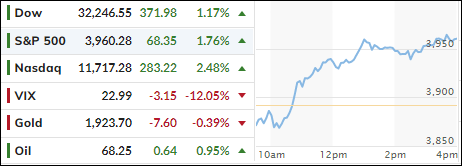
- Moving the markets
After an early dump, the major indexes shifted in reversal mode not because the banking crisis had passed but merely because a temporary fix had been found.
A consortium of 11 of the largest US Banks combined forces and agreed to a historic $30 billion unsecured deposit injection in First Republic Bank (FRC). While this is merely a band aid, and does not address how to deal with future cockroaches, it was enough to not only pull equities out of the doldrums and propel them to a solid green close, but it also wiped out FRC’s recent losses.
Bond yields rose with the 2-year climbing back above its 4% level. The US Dollar lost its recent upward momentum, while Gold slipped a tad but held on to its $1,900 level.
Reader Keith submitted an interesting question that might be of concern to you as well given the current banking crisis, of which we are only in the beginning stages—at least in my opinion:
Q: I’m a long-time subscriber to your daily emails and am curious if you could share with me and your readers, what you recommend as “safe,” given the crack that has started in our banking system.
Safely on the side has always meant short-term treasury notes and cash but if we have an unstable bank, where is our money safe?
A: I like to split the answer into two parts, since we are dealing with separate scenarios, namely investment risk and economic risk.
When you invest via a broker, and follow my Trend Tracking approach, you expose yourself to the fluctuations of equities and bonds. Once we receive a “Sell” signal, the objective is to eliminate “market risk,” since the downside danger has increased to a point where your portfolio could experience a serious decline. At that very moment, we are only concerned to move proceeds to the safety of a money market fund.
Economic risk comes into play when we start to see bank failures and bailouts, such as we are witnessing now, with a potential recession looming, which can affect your finances in a different way.
To protect against those uncertainties, you need to invest a portion of your assets into an area where 3rd party risk is eliminated. There are not too many choices, but I like gold and silver eagles in your own possession and not in a safety deposit box. You also should have some physical cash, in case the ATMs go down and, if you are so inclined, own some crypto currencies, but you must have them in your own private wallet and not on an exchange.
We are living in uncertain times and being prepared along these lines might help you to better deal with what might be coming at us in the future.
2. “Buy” Cycle Suggestions
For the current Buy cycle, which started on 12/1/2022, I suggested you reference my then current StatSheet for ETF selections. However, if you came on board later, you may want to look at the most recent version, which is published and posted every Thursday at 6:30 pm PST.
I also recommend for you to consider your risk tolerance when making your selections by dropping down more towards the middle of the M-Index rankings, should you tend to be more risk adverse. Likewise, a partial initial exposure to the markets, say 33% to start with, will reduce your risk in case of a sudden directional turnaround.
We are living in times of great uncertainty, with economic fundamentals steadily deteriorating, which will eventually affect earnings negatively and, by association, stock prices. I can see this current Buy signal to be short lived, say to the end of the year, and would not be surprised if it ends at some point in January.
In my advisor practice, we are therefore looking for limited exposure in value, some growth and dividend ETFs. Of course, gold has been a core holding for a long time.
With all investments, I recommend the use of a trailing sell stop in the range of 8-12% to limit your downside risk.
3. Trend Tracking Indexes (TTIs)
Our TTIs rebounded with the markets, but the Domestic one remains on the bearish side of its trend line. Today we saw a euphoric response and a temporary solution to the banking crisis. Both of our TTIs are sitting in neutral territory, which means a breakout to either side could occur.
This is how we closed 03/16/2023:
Domestic TTI: -0.82% below its M/A (prior close -2.00%)—Buy signal effective 12/1/2022.
International TTI: +2.73% above its M/A (prior close +1.87%)—Buy signal effective 12/1/2022.
All linked charts above are courtesy of Bloomberg via ZeroHedge.
Contact Ulli